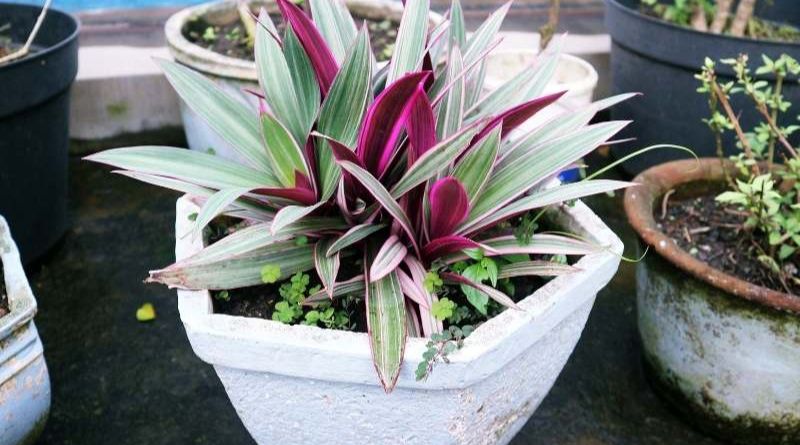The Moses in the Cradle plant, also known by its scientific name Tradescantia spathacea, is an intriguing and beautiful houseplant that has garnered attention for its unique appearance and easy care. Native to Mexico and Central America, this vibrant plant is popular for its striking foliage and attractive flowers, making it a favorite among gardeners and indoor plant enthusiasts alike. Whether you’re looking to add a splash of color to your home or brighten up your garden, the Moses in the Cradle plant is an excellent choice.
In this article, we will explore everything you need to know about the Moses in the Cradle plant, including its origin, characteristics, care requirements, and the many ways it can be used in your garden or home. We’ll also answer some frequently asked questions (FAQs) to help you successfully grow and maintain this stunning plant.
Table of Contents
What is the Moses in the Cradle Plant?
The Moses in the Cradle plant is a perennial plant that belongs to the Commelinaceae family. It is characterized by its beautiful, arching leaves and striking purple flowers that appear within a cradle-like structure formed by the plant’s bracts. These bracts are the modified leaves that surround the flower clusters, giving the plant its unique appearance. The Moses in the Cradle plant is commonly found in tropical and subtropical regions and is admired for both its ornamental beauty and ease of care.
This plant gets its name from the way the flowers are cradled by the bracts, which resemble the biblical story of baby Moses being placed in a cradle. Its colorful foliage, which is often green and purple or pink, makes it a perfect addition to any garden or indoor space. It’s especially popular for container gardens, hanging baskets, and borders.
Key Characteristics of the Moses in the Cradle Plant
The Moses in the Cradle plant stands out for its beautiful foliage and distinctive flowering structure. Here are some key characteristics of this plant:
1. Striking Foliage
The Moses in the Cradle plant is known for its bold, lance-shaped leaves that are typically dark green with purple or reddish undersides. The leaves are thick, waxy, and can grow up to 12 inches (30 cm) in length, giving the plant a lush and tropical appearance. The contrasting green and purple colors add to its visual appeal and make it a standout in both gardens and interiors.
2. Unique Flowering Structure
The most distinctive feature of the Moses in the Cradle plant is its flowers. The plant produces small, white to purple blooms that emerge from a cradle-like structure formed by the bracts, which are modified leaves that encase the flower. These bracts are usually a deep purple color, further highlighting the beauty of the small, star-shaped flowers. The flowers bloom intermittently throughout the growing season, adding a pop of color and charm to the plant.
3. Compact Growth Habit
The Moses in the Cradle plant typically grows to about 12-18 inches (30-45 cm) in height and spreads out to about 18-24 inches (45-60 cm) wide. Its compact size makes it a versatile plant that works well in containers, hanging baskets, or as ground cover in garden beds. It’s perfect for adding color to smaller spaces and can even be grown indoors.
4. Tolerates a Variety of Conditions
While the Moses in the Cradle plant is typically grown in tropical or subtropical climates, it is relatively adaptable and can thrive in a variety of environments. It prefers warm, sunny conditions but can tolerate partial shade. It is also moderately drought-tolerant once established, though it will grow best with consistent moisture.
How to Care for the Moses in the Cradle Plant
The Moses in the Cradle plant is a low-maintenance plant that doesn’t require much attention, but there are a few key care guidelines that will help ensure it thrives in your home or garden.
1. Light Requirements
The Moses in the Cradle plant prefers bright, indirect light but can also tolerate some direct sunlight. However, too much direct sunlight can scorch the leaves, so it’s best to place it in a location where it will get plenty of light without being exposed to harsh midday sun. If you’re growing it indoors, a spot near a window that gets filtered light is ideal.
2. Soil Preferences
This plant prefers well-draining, slightly acidic to neutral soil. It thrives in loamy or sandy soil that allows for proper drainage. If you’re growing it in a container, use a high-quality potting mix that drains well. If the soil retains too much moisture, it can lead to root rot, so it’s important to ensure proper drainage in both the soil and the pot.
3. Watering
The Moses in the Cradle plant enjoys moderate watering, and it’s important to let the soil dry out slightly between waterings. Overwatering can cause the roots to rot, so it’s best to water the plant thoroughly when the top inch of soil feels dry to the touch. During the growing season (spring and summer), you may need to water it more frequently, but in winter, reduce watering as the plant enters a period of dormancy.
4. Temperature and Humidity
The Moses in the Cradle plant thrives in warm temperatures ranging from 60-85°F (15-29°C). It’s best suited for USDA Hardiness Zones 9-11, but it can also be grown as an annual in cooler climates or brought indoors during the winter months. This plant prefers moderate humidity, so if you’re growing it indoors, occasional misting or placing it near a humidifier can help maintain the moisture it prefers.
5. Fertilization
During the growing season, you can feed the Moses in the Cradle plant once a month with a balanced, water-soluble fertilizer to encourage healthy growth. In the fall and winter months, the plant doesn’t need as much fertilization, so you can reduce feeding or stop altogether. Avoid over-fertilizing, as this can result in leggy growth and a decline in the plant’s overall appearance.
6. Pruning
The Moses in the Cradle plant generally does not require heavy pruning. However, if the plant becomes too leggy or overgrown, you can trim back any dead or damaged leaves to encourage more compact growth. Pruning can also be done to control the plant’s size if it becomes too large for its space. Make sure to use clean, sharp scissors or pruning shears to prevent spreading any potential disease.
7. Repotting
If you’re growing the Moses in the Cradle plant in a container, you may need to repot it every couple of years as it grows. Choose a pot that is only slightly larger than the current one to avoid water retention issues. Repotting can also be an opportunity to divide the plant if it has developed several offshoots or if you wish to propagate it.
Common Uses for the Moses in the Cradle Plant
The Moses in the Cradle plant is highly versatile and can be used in various settings, both indoors and outdoors:
- Container Gardening: Its compact size makes it an excellent choice for container gardens. It can be placed on patios, balconies, or windowsills to add color and texture.
- Ground Cover: In garden beds, this plant works well as a ground cover due to its spreading nature and attractive foliage.
- Hanging Baskets: The plant’s trailing growth habit makes it perfect for hanging baskets, where its colorful leaves can cascade down beautifully.
- Indoor Plant: The Moses in the Cradle plant can be grown indoors as a low-maintenance houseplant. It works particularly well in spaces with bright, indirect light.
- Flower Beds: Its striking foliage and occasional flowers make it an attractive addition to flower beds and mixed plantings.
FAQs About the Moses in the Cradle Plant
1. Is the Moses in the Cradle plant toxic to pets?
No, the Moses in the Cradle plant is not toxic to pets. However, as with any plant, it’s always a good idea to keep it out of reach of curious animals that might chew on it.
2. Can I propagate the Moses in the Cradle plant?
Yes, you can propagate the Moses in the Cradle plant by division or stem cuttings. To divide the plant, carefully separate the offshoots from the main plant and replant them in fresh soil. You can also propagate from cuttings by rooting them in water or directly in soil.
3. Why are the leaves on my Moses in the Cradle plant turning yellow?
Yellowing leaves can be a sign of overwatering, poor drainage, or too much direct sunlight. Ensure that the soil has good drainage, and water only when the soil is dry to the touch. Also, ensure that the plant is not exposed to harsh direct sunlight for prolonged periods.
4. Can I grow the Moses in the Cradle plant indoors?
Yes, the Moses in the Cradle plant is well-suited for indoor growth, as long as it receives bright, indirect light. Place it near a window with filtered sunlight or use artificial grow lights if necessary.
5. **How often should I water the **Moses in the Cradle
plant**?** Water the Moses in the Cradle plant when the top inch of soil feels dry. During the growing season, this might be once a week or every 10 days, but in winter, reduce watering to prevent the plant from sitting in soggy soil.
Conclusion
The Moses in the Cradle plant is a stunning, low-maintenance plant that can add beauty and color to any indoor or outdoor space. With its striking foliage, unique flowers, and resilience in a variety of growing conditions, it’s easy to see why this plant is so popular among gardeners. Whether you’re looking to add a touch of tropical flair to your home or create a vibrant garden display, the Moses in the Cradle plant is an excellent choice. By following simple care guidelines, you can enjoy this beautiful plant for many years to come.



